
Nutrition:
-
Feed in meals,
one or two times a day. No using self-feeders. By feeding in meals,
there will be no overeating, the food will stay fresher, and you
can control the food intake. If you prefer to free feed, still monitor intake so you know if your dog is not feeling well. Other options that we implement are feeding in treat dispensing toys (for additional mental stimulation and activity) and withholding some of the daily ration to use as rewards for good behavior throughout the day (rewarded behavior continues!).
- If your dog is active during the day, you should consider feeding in the evening,
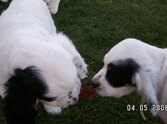 instead of the morning, so that he does not over exert himself post-eating (risk factor to bloat). instead of the morning, so that he does not over exert himself post-eating (risk factor to bloat).
- Do Not engage your dog in intense activity until at least two hours after eating. Do not feed after exercise until your dog has the chance to cool down his body temperature.
- If your dog is bolting his food (eating really fast), try the Brakefast bowl, treat dispensing toy, or put the food on a jelly roll baking pan to slow him down.
- Invest in an
above-the-ground feeder or bowl to prevent spills, keep insects
out, and make eating and digestion easier. Mini horse feeders and
buckets work great for food and water. Adjust it to the shoulder height of your dog.
- Buy the
best quality dog food you can afford and that your dog does well on. Things to pay attention to are the general health and luster, condition/weight, or digestion patterns of your dog. Active bird dogs often do good on a diet of at least 30% protein and 20% fat. For links to nutritional articles, click here.
- Dog foods are not made equally, and while reading the labels can give you a better
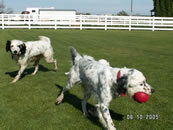 idea of the contents of the food than trusting all the marketing, it won't tell you everything or anything about actual quality. Talk to fellow hunters, breeders, and trainers to get a feel of what might work for you. Remember, just because there is a big brand name on the bag, it doesn't always mean the food is high-quality. Oftentimes, the high quality natural dog foods (California Natural, SolidGold, Eagle Pack, Wellness, Canidae etc) will be from companies of which that the mass public has never heard. On the other hand, working dogs can do well even on Sam's Club Exceed and Kirkland Signature formulas (manufactured by Diamond brand). Some things to pay attention to are checking the guaranteed analysis and metabolizable energy (kcal/cup). Specified meat meals (ie chicken meal, lamb meal, etc) in the first three ingredients is more important than a listed meat alone (ie chicken, lamb) because the latter is weighed while still containing water. idea of the contents of the food than trusting all the marketing, it won't tell you everything or anything about actual quality. Talk to fellow hunters, breeders, and trainers to get a feel of what might work for you. Remember, just because there is a big brand name on the bag, it doesn't always mean the food is high-quality. Oftentimes, the high quality natural dog foods (California Natural, SolidGold, Eagle Pack, Wellness, Canidae etc) will be from companies of which that the mass public has never heard. On the other hand, working dogs can do well even on Sam's Club Exceed and Kirkland Signature formulas (manufactured by Diamond brand). Some things to pay attention to are checking the guaranteed analysis and metabolizable energy (kcal/cup). Specified meat meals (ie chicken meal, lamb meal, etc) in the first three ingredients is more important than a listed meat alone (ie chicken, lamb) because the latter is weighed while still containing water.
- Do not feed your dog old foods that you would not eat! Dogs can get sick from
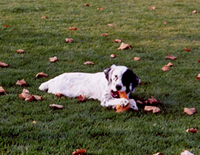 spoiled foods. Other foods to avoid feeding are (but not limited to) onions, peanuts, grapes, chocolates, pork, spices, cooked meat bones, cooked poultry bones, apple cores, and cherries. spoiled foods. Other foods to avoid feeding are (but not limited to) onions, peanuts, grapes, chocolates, pork, spices, cooked meat bones, cooked poultry bones, apple cores, and cherries.
- Have you ever considered feeding a Raw diet, BARF diet, or SARF diet? With a bit of knowledge and background on the owner's parts, these natural diets can be very beneficial. Keep in mind there is no "best" diet because what works for one may not work for another. There are many articles online and books published on the subject.
- Always have
fresh, easily-accessible water, and keep it cool in summer and warm
in winter. Hydration is the most important factor in your dog's
life.
Top | Training, Behavior, & Exercise | Education & Health

Supplies and Home:
-
We love versatile products! Take, for instance, the adjustable
nylon horse tie-down. It can be used as a leash, tie down, short
tie-out, collar/leash combo, etc. for home, traveling, bathing,
grooming, hunting, emergencies, etc. They are extremely versatile
and durable. And for less than $10 from Schneiders, we bought a pair of durable, black Dura-Tech Split Rope Draw Reins that we not 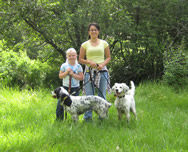 only use for bitting up horses but also as a short, sturdy check cord for pups, quick/versatile lead, and effective tool for training whoa/heel. only use for bitting up horses but also as a short, sturdy check cord for pups, quick/versatile lead, and effective tool for training whoa/heel.
- Owning dogs doesn't have to cost a fortune! Resist purchasing supplies, toys, and health-care products from pet stores; instead, comparison shop catalog/online suppliers, like Valley Vet, Drs. Foster & Smith, Amazon, and Jeffers Pet.
- Keep toys,
bowls, buckets, yards, beds, doghouses, and kennels washed and clean! Clean
environments reduce the chances for parasitic infestations and other
illnesses. Also make sure they are all intact, with no loose parts that might be ingested by or cut your dog.
- Speaking of dog toys, our top choices are the KONG, Starmark, and Premier Petsafe products. We keep a variety of them on hand and fill them with healthy treats to help bored pups get through the day. Similar durable products are also available. While your dog will doubtlessly have a favorite type of toy, I suggest all owners purchase something like these, too.
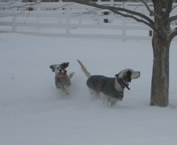
- Get your outdoor dog a waterproof
dog blanket if you live in really wet or cold climates. Each of our dogs wears their custom-made blankets,
by Horse Creations, throughout the winter to keep more comfortable and active. We also recommend and use Weatherbeeta brand dog blankets, economical yet higher quality than many available.
- For snow or ice packed paws, make sure you trim the hair up between the paw pads (on the underside) and apply shortening, cooking spray, or Mushers Secret type of products. If that isn't enough, seriously consider purchasing waterproof, insulated/lined dog boots. Paws can get frostbitten.
- Permanent identification
could make all the difference if your dog gets lost at home or on
hunting trips, vacations,…. RLS highly recommends having your pet microchipped. Vets and shelters have universal-readers, so your pet will have a much better chance at being identified and returned.
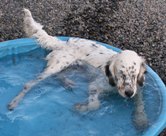 Don’t neglect the tags, though, as they
are easily read by everyone. Don’t neglect the tags, though, as they
are easily read by everyone.
- Get a kiddy
pool for your dog in the summer to help keep him cool. Change water daily for prevention
of mosquitoes, etc. Make sure he also has a dry place to escape the heat.
- Designate an
area in your home for your dog, such as a bed or dog crate- he will appreciate a safe haven of his
own. In the yard, give him a kennel for safe-keeping and structure, too. We do not recommend leaving dogs loose in urban/suburban yards during the day even if they are fully fenced.
- It is important to keep your dog in a fenced or well-contained area so that it is not free to roam at large. Just some of the risks of running unsupervised are self-hunting, poison/ingestion of troublesome things, annoyed neighbors (and any actions they might take), car accidents, theft/loss, etc.
Top | Supplies & Home| Education & Health

Training, Behavior,
and Exercise: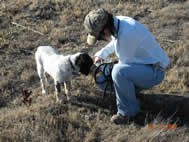
-
Let your pup be a pup his first year and don't pressure him. Take him out to fields and different environments as much as possible so he can have fun, get used to the little things, and learn on his own.
- For typical obedience training, always set
your dog up for success and never for failure.
REWARD behavior you want; the behaviors that are not rewarded will go extinct. There is no need to use "positive punishment" ie corrections in training and such actually inhibit progress and motivation.
- Learn your quadrants of operant conditioning, about classical conditioning, about marker training, and concepts such as Premack! Learn how you can best utilize positive reinforcement to accomplish most of your training. Learn why pack leader theories in dogs is not supported by science and is not only harmful to training but actually potentially dangerous. Learn why positive punishment and negative reinforcement have high rates of fallout, suppression, shut down, and learned helplessness (learn what those are). Learn how properly modify behavior through counter conditioning and desensitization, rather than flooding and suppression. Learn about extinction. Learn about calming signals, stress signals, distance increasing/decreasing signals, displacement behaviors, and other body language. Check out LIMA, Humane Hierarchy, and Progressive Reinforcement principles. This will all help you to become a better owner and trainer. Our resource/links page has tons of great links by qualified, educated trainers and behaviorists.
- Don’t
rush your dog’s training. Progress only when the do
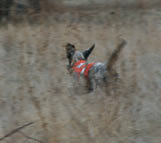 g is consistently succeeding, and make sure you practice the behavior in many different locations and contexts to help the dog "generalize" that behavior. All behaviors need to be "proofed" for performing at a Distance, with Distractions, and for Duration. Work on one "D" at a time and be sure to decrease the criteria occasionally rather than constantly increasing. g is consistently succeeding, and make sure you practice the behavior in many different locations and contexts to help the dog "generalize" that behavior. All behaviors need to be "proofed" for performing at a Distance, with Distractions, and for Duration. Work on one "D" at a time and be sure to decrease the criteria occasionally rather than constantly increasing.
- Reinforced behavior gets repeated. Reinforcement is as the dog perceives--so even upset attention or yelling may be just enough attention for the dog to find it rewarding. Instead, ignore--withhold your attention until the appropriate behavior occurs, and then give your dog your attention (the reward).
- Electronic collars should only be used to reinforce or correct commands your dog HAS ALREADY LEARNED if at all and with the guidance of a professional trainer who understands operant conditioning.
- If you buy an
e-collar, purchase one with many levels, and vibrate/shock options, so that you can tailor the
level just to your dog's needs.
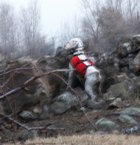 E-collars should typically be at a high
enough level to get the dog's attention, not high enough to cause pain; however, even then you will run the risk of fallout, shutdown, and/or learned helplessness. Annoyances can still be aversive. E-collars should typically be at a high
enough level to get the dog's attention, not high enough to cause pain; however, even then you will run the risk of fallout, shutdown, and/or learned helplessness. Annoyances can still be aversive.
- Daily walks or jogs can be very beneficial.
These activities reduce boredom
and increases exercise and conditioning. Get more out of your walks by stopping periodically and cue other behaviors. Playing and running in
the yard is generally not sufficient, especially for working dogs. Other forms of exercise include play with a "flirt pole," nose work, trick training, interactive toys, tug (yes, tug, even for bird dogs), and approved-destructables.
- Pulling on leashes is very common because dogs have an opposition REFLEX (they aren't being stubborn). There are many resources on "loose leash walking" online, as well as methods like "Silky Leash" to help increase leash responsiveness. If your dog pulls, we highly recommend stopping using the collars (which have many potential health risks), and using a back clip harness (focus on LLW) or a front clip harness (a good "bandaid" for while you are working on LLW).
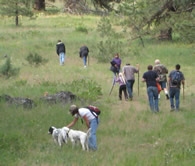
- When training,
if you feel yourself getting angry or stressed, ask your dog to do
one last command that he will definitely be successful with and end
the session. Dogs learn better with frequent, regular short sessions that are fun and non-threatening!
- Don’t
punish bad behavior such as digging, barking, misplaced chewing… Prevent the problem at its source! Boredom and frustration can be greatly via exercise,
Kongs, chew toys, long-lasting treats, activity….
-
Never tie a dog up with any sort of tightening collar, be it a martingle, choke chain, prong collar, etc. That sounds like common sense, but people do it.
- Keep your dog
occupied year round- swim, walk, train, play, hike, HUNT. Join a local training, hunting, or bird dog club- you and your dog will learn and have fun!
Top | Supplies & Home | Training, Behavior, & Exercise

Education and Health:
-
Keep your dog
up to date with yearly health checks by your vet, wormings, and grooming. Stay up to date with your chosen vaccination regimen.
-
Previously, we were dedicated to our annual vaccination schedule; 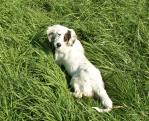 however, due to some recent readings of articles, studies, and personal accounts of vaccinosis, we have re-examined our protocol for vaccinations. Please note, that this is a personal choice of RLS, and we encourage you to make an informed decision, too. Please read articles on the subjects (some are included here), talk with your vet, and others active in the hunting/dog community, before you form a view on vaccinations/vaccinosis and make a huge, important decision that concerns the well-being of your pet. however, due to some recent readings of articles, studies, and personal accounts of vaccinosis, we have re-examined our protocol for vaccinations. Please note, that this is a personal choice of RLS, and we encourage you to make an informed decision, too. Please read articles on the subjects (some are included here), talk with your vet, and others active in the hunting/dog community, before you form a view on vaccinations/vaccinosis and make a huge, important decision that concerns the well-being of your pet.
-
Consult your
veterinarian or breeder whenever you have a concern about your pet’s
health. They are here to help.
-
While we recommend the general neutering of non-working and mixed-breed dogs, as well as poor quality, non-competitive, purebred dogs, we have come across information that makes us know reconsider when and why working dog owners should have their animals neutered. Please read about both sides of the procedures, since we are unfairly often only presented one side. It is important that you make this decision with the best judgement and consideration for the quality of life for your dog.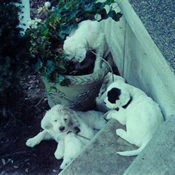
- Always make
sure your pet has several options for getting out of the weather,
whether it is the heat, cold, or rain.
- Learn what
kind of foods, plants, household, and lawn care products are harmful
to your pets.
- Education never
ends! Keep doing all you can to learn about your dog- (s)he is your
RESPONSIBILITY and you can't just take care of them like little people. They have different behavior and needs.
- Not sure about
something? If you need assistance researching, please ask RLS for
help. It is always beneficial for the Rocks to continue their studying
of the different aspects of dogs, so they’d be glad to give
you a hand.
Top | Supplies & Home | Training, Behavior, & Exercise | Education & Health |

 instead of the morning, so that he does not over exert himself post-eating (risk factor to bloat).
instead of the morning, so that he does not over exert himself post-eating (risk factor to bloat). idea of the contents of the food than trusting all the marketing, it won't tell you everything or anything about actual quality. Talk to fellow hunters, breeders, and trainers to get a feel of what might work for you. Remember, just because there is a big brand name on the bag, it doesn't always mean the food is high-quality. Oftentimes, the high quality natural dog foods (California Natural, SolidGold, Eagle Pack, Wellness, Canidae etc) will be from companies of which that the mass public has never heard. On the other hand, working dogs can do well even on Sam's Club Exceed and Kirkland Signature formulas (manufactured by Diamond brand). Some things to pay attention to are checking the guaranteed analysis and metabolizable energy (kcal/cup). Specified meat meals (ie chicken meal, lamb meal, etc) in the first three ingredients is more important than a listed meat alone (ie chicken, lamb) because the latter is weighed while still containing water.
idea of the contents of the food than trusting all the marketing, it won't tell you everything or anything about actual quality. Talk to fellow hunters, breeders, and trainers to get a feel of what might work for you. Remember, just because there is a big brand name on the bag, it doesn't always mean the food is high-quality. Oftentimes, the high quality natural dog foods (California Natural, SolidGold, Eagle Pack, Wellness, Canidae etc) will be from companies of which that the mass public has never heard. On the other hand, working dogs can do well even on Sam's Club Exceed and Kirkland Signature formulas (manufactured by Diamond brand). Some things to pay attention to are checking the guaranteed analysis and metabolizable energy (kcal/cup). Specified meat meals (ie chicken meal, lamb meal, etc) in the first three ingredients is more important than a listed meat alone (ie chicken, lamb) because the latter is weighed while still containing water. spoiled foods. Other foods to avoid feeding are (but not limited to) onions, peanuts, grapes, chocolates, pork, spices, cooked meat bones, cooked poultry bones, apple cores, and cherries.
spoiled foods. Other foods to avoid feeding are (but not limited to) onions, peanuts, grapes, chocolates, pork, spices, cooked meat bones, cooked poultry bones, apple cores, and cherries. only use for bitting up horses but also as a short, sturdy check cord for pups, quick/versatile lead, and effective tool for training whoa/heel.
only use for bitting up horses but also as a short, sturdy check cord for pups, quick/versatile lead, and effective tool for training whoa/heel. 
 Don’t neglect the tags, though, as they
are easily read by everyone.
Don’t neglect the tags, though, as they
are easily read by everyone.
 g is consistently succeeding, and make sure you practice the behavior in many different locations and contexts to help the dog "generalize" that behavior. All behaviors need to be "proofed" for performing at a Distance, with Distractions, and for Duration. Work on one "D" at a time and be sure to decrease the criteria occasionally rather than constantly increasing.
g is consistently succeeding, and make sure you practice the behavior in many different locations and contexts to help the dog "generalize" that behavior. All behaviors need to be "proofed" for performing at a Distance, with Distractions, and for Duration. Work on one "D" at a time and be sure to decrease the criteria occasionally rather than constantly increasing. E-collars should typically be at a high
enough level to get the dog's attention, not high enough to cause pain; however, even then you will run the risk of fallout, shutdown, and/or learned helplessness. Annoyances can still be aversive.
E-collars should typically be at a high
enough level to get the dog's attention, not high enough to cause pain; however, even then you will run the risk of fallout, shutdown, and/or learned helplessness. Annoyances can still be aversive.
 however, due to some recent readings of articles, studies, and personal accounts of vaccinosis, we have re-examined our protocol for vaccinations. Please note, that this is a personal choice of RLS, and we encourage you to make an informed decision, too. Please read articles on the subjects (some are included here), talk with your vet, and others active in the hunting/dog community, before you form a view on vaccinations/vaccinosis and make a huge, important decision that concerns the well-being of your pet.
however, due to some recent readings of articles, studies, and personal accounts of vaccinosis, we have re-examined our protocol for vaccinations. Please note, that this is a personal choice of RLS, and we encourage you to make an informed decision, too. Please read articles on the subjects (some are included here), talk with your vet, and others active in the hunting/dog community, before you form a view on vaccinations/vaccinosis and make a huge, important decision that concerns the well-being of your pet. 